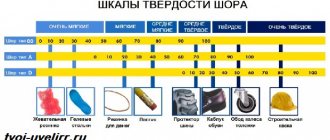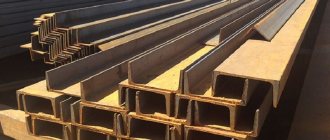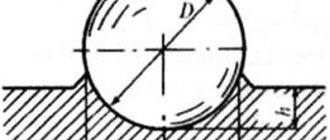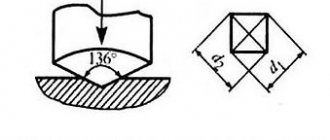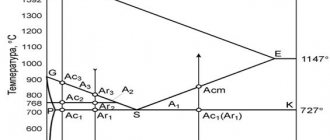Hardness comparison table. Conversion of hardness according to BRINELL, ROCKWELL, VICKERS and SHORE.
Thanks to this table, you can easily convert values from quantities such as hb to others, such as hrc. Hardness is the property of a material to resist the penetration of another body into it.
| d10, mm | According to BRINELL HB | According to ROCKWELL H.R.C. | According to VICKERS H.V. | By SHORE HSD |
| 2,3 | 712 | 66,4 | 1016 | 98,3 |
| 2,4 | 653 | 62,9 | 866 | 92,9 |
| 2,5 | 601 | 59,3 | 750 | 86,5 |
| 2,6 | 555 | 55,8 | 658 | 80,0 |
| 2,7 | 514 | 52,5 | 586 | 73,7 |
| 2,8 | 477 | 49,4 | 528 | 68,1 |
| 2,9 | 444 | 46,5 | 481 | 63,2 |
| 3,0 | 415 | 43,8 | 441 | 58,9 |
| 3,1 | 388 | 41,4 | 408 | 55,1 |
| 3,2 | 363 | 39,1 | 378 | 51,7 |
| 3,3 | 341 | 36,9 | 352 | 48,6 |
| 3,4 | 321 | 34,7 | 328 | 45,8 |
| 3,5 | 302 | 32,5 | 307 | 43,2 |
| 3,6 | 285 | 30,3 | 288 | 40,7 |
| 3,7 | 269 | 28,1 | 271 | 38,4 |
| 3,8 | 255 | 26,0 | 256 | 36,2 |
| 3,9 | 241 | 24,0 | 242 | 34,2 |
| 4,0 | 229 | 22,0 | 229 | 32,5 |
| 4,1 | 217 | 20,1 | 217 | 30,9 |
| 4,2 | 206 | 17,9 | 206 | 29,4 |
| 4,3 | 197 | — | 196 | 28,1 |
| 4,4 | 187 | — | 186 | 26,9 |
| 4,5 | 179 | — | 177 | 25,7 |
| 4,6 | 170 | — | 169 | 24,5 |
| 4,7 | 163 | — | 162 | 23,2 |
| 4,8 | 156 | — | 155 | 22,0 |
| 4,9 | 149 | — | 149 | 21,0 |
| 5,0 | 143 | — | 143 | 20,6 |
Methods for determining hardness:
The BRINELL method is a hardness test using a steel ball by pressing it into the test surface. Steel balls come in diameters of 2.5; 5 or 10 mm. The Brinell hardness number (HB) is the ratio of the load to the surface area of the print.
The Rockwell method is a hardness test using a diamond cone with an angle of 120* or a hardened steel ball, by pressing into the test surface.
The Vickers method is a hardness test using a diamond tip in the shape of a regular tetrahedral pyramid with an angle between the faces of 136 *, by pressing into the test surface. The Vickers hardness number is the ratio of the load to the surface area of the indentation.
Shore's method is the determination of hardness by the height of the rebound of the striker falling onto the surface of the test body from a certain height.
| Rockwell | Brinell | Vickers | Shore | To break | ||
| HRA | H.R.C. | HB(3000H) | Print diameter, mm | H.V. | HSD | N/mm² |
| 89 | 72 | 782 | 2.20 | 1220 | ||
| 86.5 | 70 | 1076 | 101 | |||
| 86 | 69 | 744 | 2.25 | 1004 | 99 | |
| 85.5 | 68 | 942 | 97 | |||
| 85 | 67 | 713 | 2.30 | 894 | 95 | |
| 84.5 | 66 | 854 | 92 | |||
| 84 | 65 | 683 | 2.35 | 820 | 91 | |
| 83.5 | 64 | 789 | 88 | |||
| 83 | 63 | 652 | 2.40 | 763 | 87 | |
| 82.5 | 62 | 739 | 85 | |||
| 81.5 | 61 | 627 | 2.45 | 715 | 83 | |
| 81 | 60 | 695 | 81 | 2206 | ||
| 80.5 | 59 | 600 | 2.50 | 675 | 80 | 2137 |
| 80 | 58 | 2.55 | 655 | 78 | 2069 | |
| 79.5 | 57 | 578 | 636 | 76 | 2000 | |
| 79 | 56 | 2.60 | 617 | 75 | 1944 | |
| 78.5 | 55 | 555 | 598 | 74 | 1889 | |
| 78 | 54 | 2.65 | 580 | 72 | 1834 | |
| 77.5 | 53 | 532 | 562 | 71 | 1772 | |
| 77 | 52 | 512 | 2.70 | 545 | 69 | 1689 |
| 76.5 | 51 | 495 | 2.75 | 528 | 68 | 1648 |
| 76 | 50 | 513 | 67 | 1607 | ||
| 75.5 | 49 | 477 | 2.80 | 498 | 66 | 1565 |
| 74.5 | 48 | 460 | 2.85 | 485 | 64 | 1524 |
| 74 | 47 | 448 | 2.89 | 471 | 63 | 1496 |
| 73.5 | 46 | 437 | 2.92 | 458 | 62 | 1462 |
| 73 | 45 | 426 | 2.96 | 446 | 60 | 1420 |
| 72.5 | 44 | 415 | 3.00 | 435 | 58 | 1379 |
| 71.5 | 42 | 393 | 3.08 | 413 | 56 | 1317 |
| 70.5 | 40 | 372 | 3.16 | 393 | 54 | 1255 |
| 38 | 352 | 3.25 | 373 | 51 | 1193 | |
| 36 | 332 | 3.34 | 353 | 49 | 1138 | |
| 34 | 313 | 3.44 | 334 | 47 | 1076 | |
| 32 | 297 | 3.53 | 317 | 44 | 1014 | |
| 30 | 283 | 3.61 | 301 | 42 | 965 | |
| 28 | 270 | 3.69 | 285 | 41 | 917 | |
| 26 | 260 | 3.76 | 271 | 39 | 869 | |
| 24 | 250 | 3.83 | 257 | 37 | 834 | |
| 22 | 240 | 3.91 | 246 | 35 | 793 | |
| 20 | 230 | 3.99 | 236 | 34 | 75 | |
Mohs hardness scale
The Mohs scale (mineralogical hardness scale) is a qualitative ordinal scale that characterizes the scratch resistance of various minerals. Used to determine the relative hardness of mineral samples.
Based on the ability of a harder material to scratch a softer material.
The scale contains 10 minerals as reference minerals, ranking them in order of increasing hardness from very soft (talc) to very hard (diamond).
All of the minerals in the table, except diamond, are relatively common and easy or inexpensive to obtain.
- — Talc
- — Plaster
- — Calcite
- — Fluorite
- — Apatite
- — Orthoclase
- — Quartz
- — Topaz
- — Corundum
- — Diamond
If a mineral scratches a standard, then its hardness is higher; if it is scratched by a standard, it means lower.
The Mohs scale was created in 1812 and named after its inventor, German geologist and mineralogist Friedrich Mohs. Since then, many different methods for determining hardness have been invented: the Brinell, Knoop, Rockwell, Shore, Vickers method.
Mohs hardness is a relative integer comparison of scratch resistance.
Other hardness measurement methods rely on indentation resistance. For testing, an “Indenter” is used, which is pressed into the test sample with a carefully measured force. The size or depth of the notch in the specimen and the magnitude of the force are then used to calculate the hardness value. Because each of these tests uses different apparatus and different calculations, they cannot be directly compared to each other.
The Mohs scale has become widespread because... The hardness test method is easy to perform, inexpensive and quickly understood by people.
Despite its lack of accuracy, the scale is useful for field geologists who use it for rough identification of minerals when examining easily identifiable samples or when more complex tests are not available.
Some use readily available items for a quick test. For example, a geologist may have a pocket knife that can be used to determine whether a sample is harder or softer than a Mohs value of 5-6.5.
- 1 - Pencil
- 2 - Table salt
- 2-2.5 - Can be scratched with a fingernail
- 2.5-3 - Gold, silver
- 3 – Copper coin
- 4-4.5 - Nail
- 4-5 - Iron
- 5 - Glass
- 5-6.5 - Knife blade
- 6.5 - Steel file
- 7 - Easily scratches glass
- 7+ — Hardened steel file
- 8 - Sandpaper, mineral scratches glass very easily
- 9 – Mineral cuts glass
- 10 - Used as a glass cutter
Below is an extended table of substances, minerals, and precious stones:
| Substance or mineral | Mohs hardness |
| Pyrophyllite, molybdenite | 1-2 |
| Bauxite, coal | 1-3 |
| Limonite | 1-5 |
| Ice, sugar, gallium, strontium, indium, tin, barium, thallium, lead, graphite | 1,5 |
| Gypsum, calcium | 1,5-2 |
| Sulfur | 1,5-2,5 |
| Sylvite, glauconite, cadmium, selenium | 2 |
| Rock salt, cinnabar, chlorite, bismuth, amber | 2-2,5 |
| Muscovite | 2-3 |
| Silver, gold, galena, copper, biotite, mica | 2,5-3 |
| Aluminum, limestone, calcite, boric acid, nitrophoska | 3 |
| Aragonite, witherite, anhydrite | 3-3,5 |
| Pearl, brass, arsenic | 3-4 |
| Serpentine | 3-5 |
| Sphalerite, rhodochrosite, malachite, dolomite, cuprite, chalcopyrite, azurite, barite | 3,5-4 |
| Siderite, pyrrhotite, dolomite | 3,5-4,5 |
| Fluorite, phosphor bronze | 4 |
| Marble | 4-5 |
| Tooth enamel, asbestos, apatite, manganese, zirconium, palladium, obsidian | 5 |
| Titanite, monazite | 5-5,5 |
| Jade, uraninite, ilmenite, enstatite, porcelain stoneware (polished) | 5-6 |
| Magnetite | 5-6,5 |
| Nepheline, augite, arsenopyrite, actinolite, bustamite, cobaltite | 5,5-6 |
| Rhodonite, diopside, opal, red iron ore | 5,5-6,5 |
| Titanium, germanium, niobium, rhodium, uranium | 6 |
| Rutile, pyrite, prehnite, plagioclase, orthoclase, amazonite, andesine, anorthoclase, benitoite, helvite, iridium | 6-6,5 |
| Silicon | 6,5 |
| Jasper | 6,5-7 |
| Agate, zoisite, epidote, cassiterite, pyrolusite | 6-7 |
| Marcasite | 6-7,5 |
| Granite, tanzanite, spodumene, olivine, jadeite, axinite, chrysoprase, jadeite | 6,5-7 |
| Sillimanite, garnet | 6,5-7,5 |
| Quartz, stone pebbles, amethyst, aventurine, forsterite, osmium, silicone, rhenium, vanadium | 7 |
| Tourmaline, cordierite, almandine, boracite, cordierite, danburite | 7-7,5 |
| Zircon, andalusite, euclase, hambergite, sapphirine | 7,5 |
| Emerald, hardened steel, tungsten, spinel, beryl, beryllium, aquamarine, red beryl, ganite, painite | 7,5-8 |
| Topaz, cubic zirconia | 8 |
| Chrysoberyl, alexandrite, choltite | 8,5 |
| Porcelain tiles (unpolished) | 8,5 |
| Corundum, ruby, sapphire, alundum, chrome | 9 |
| Moissanite, boron | 9,5 |
| Carborundum | 9-10 |
| Diamond, carbonado | 10 |
Table of Mohs hardness values for various materials
Table of Mohs hardness values of various materials.
| Substance | Mohs hardness | Substance | Mohs hardness |
| Agate / Agate | 6-7 | Brass/Brass | 3-4 |
| Alabaster | 1.7 | Lithium | 0.6 |
| Diamond | 10 | Loess (at 0°) | 0.3 |
| Aluminum | 2-2.9 | Magnesium / Magnesium | 2.0 |
| Alundum (electrocorundum) / Alundum | 9+ | Magnetic iron ore (magnetite) / Magnetite | 6 |
| Andalusite / Andalusite | 7.5 | Manganese / Manganese | 5.0 |
| Anthracite / Anthracite | 2.2 | Marble | 3-4 |
| Antimony / Antimony | 3.0-3.3 | Meerschaum / Meerschaum | 2-3 |
| Apatite / Apatite | 5 | Copper | 2.5-3 |
| Aragonite (wavy limestone) / Aragonite | 3.5 | Emery (corundum) / Emery | 7-9 |
| Arsenic/Arsenic | 3.5 | Sodium/Sodium | 0.4 |
| Asbestos / Asbestos | 5 | Opal | 4-6 |
| Asphalt | 1-2 | Osmium / Osmium | 7.0 |
| Augite / Augite | 6 | Tin/Tin | 1.5-1.8 |
| Antigorite / Serpentine | 3-4 | Feldspar/Orthoclase | 6 |
| Stibnite | 2 | Palladium | 4.8 |
| Barium sulfate / Barite | 3.3 | Platinum | 4.3 |
| Bell bronze/ Bell-metal | 4 | Feldspar / Feldspar | 6 |
| Beryl / Beryl | 7.8 | Fluorspar/Fluorite | 4 |
| Bismuth | 2.5 | Pumice / Pumice | 6 |
| Boric acid | 3 | Hornblende / Hornblende | 5.5 |
| Bor / Boron | 9.5 | Rubidium / Rubidium | 0.3 |
| Wax / Wax (at 0°) | 0.2 | Ruthenium / Ruthenium | 6.5 |
| Galena / Galena | 2.5 | Silver | 2.5-4 |
| Gallium | 1.5 | Sulfur/Sulfur | 1.5-2.5 |
| Garnet / Garnet | 6.5-7 | Glass | 4.5-6.5 |
| Graphite | 0.5-1 | Lead/Lead | 1.5 |
| Gypsum / Gypsum | 1.6-2 | Mica/Mica | 2.8 |
| Diatomite / Diatomaceous Earth | 1-1.5 | Platinum-iridium alloy / Plat-iridium | 6.5 |
| Dolmite / Dolomite | 3.5-4 | Sulfur (iron) pyrite, pyrite / Pyrite | 6.3 |
| Iron | 4-5 | Selenium | 2.0 |
| Gold | 2.5-3 | Steel | 5-8.5 |
| Lime spar/Calcite | 3 | Wood's Metal | 3 |
| Indium | 1.2 | Strontium / Strontium | 1.8 |
| Iridium / Iridium | 6-6.5 | Talc | 1 |
| Cadmium | 2.0 | Tellurium / Tellurium | 2.3 |
| Calamine | 5 | Topaz | 8 |
| Calcium | 1.5 | Tourmaline / Tourmaline | 7.3 |
| Carborundum, silicon carbide / Carborundum | 9-10 | Carbon (pure) / Carbon | 10.0 |
| Potassium/Potassium | 0.5 | Phosphorus / Phosphorus | 0.5 |
| Rock Salt (halite) | 2 | Phosphor Bronze / Phosphorbronze | 4 |
| Quartz | 7 | Chrome / Chromium | 9.0 |
| Alum shale/Alum | 2-2.5 | Silver Chloride | 1.3 |
| Corundum / Corundum | 9 | Cesium | 0.2 |
| Flint Pebbles/Flint | 7 | Zinc | 2.5 |
| Red iron ore, hematite / Hematite | 6 | Amber/Amber | 2-2.5 |
| Kaolinite / Kaolinite | 2.0-2.5 | ||
| Silicon | 7.0 |
Hardness determination method (Brinell, Rockwell, Vickers)
The simplest mechanical property is hardness. Methods for determining hardness, depending on the speed of application of the load, are divided into static and dynamic, and according to the method of its application - into indentation and scratching methods. Methods for determining hardness according to Brinell, Rockwell, Vickers are static testing methods.
Hardness is the ability of a material to resist being pressed into it by a harder body (indenter) under the influence of external forces.
When testing for hardness, a pyramid, cone or ball (indenter) is pressed into the surface of materials, and therefore the test methods are distinguished according to Vickers, Rockwell and Brinell, respectively. In addition, there are less common hardness testing methods: the elastic rebound method (Shore), the comparative hardness method (Poldi) and some others.
When testing materials for hardness, standard special samples are not made, but certain requirements are imposed on the size and surface of samples and products.
Hardness is judged either by the area of the resulting indentation or by the depth of indentation of the indenter. As a result of indentation with a sufficiently large load, the surface layers of the metal located under the tip and near it receive plastic deformation. After removing the load, an imprint remains on the sample (part). Small volume of deformable metal, the ability to conduct tests on the surfaces of bodies of various shapes and sizes on parts of small thickness and in very thin layers of metal, without using specially made samples, speed and simplicity of testing, as well as the ability to judge its properties without destroying the product due to the existence of quantitative The relationship between the hardness of ductile metals and other mechanical properties (tensile strength) makes hardness testing an indispensable production method for mass metal testing.
The surface of the sample or test product for hardness measurement must be flat, smooth, free of oxide film and represent a horizontal polished area. The samples must be stable; when testing irregularly shaped samples, wedge-shaped stands must be used.
Hardness measurement using the Brinell method Hardness measurement according to Brinell is regulated by GOST 9012-59 “Metals. Brinell hardness measurement method"
Tests are carried out on special presses - hardness testers, developing a strictly defined indentation force, which is standard with a load of 3000, 1000, 750 and 250 kgf
A hardened steel ball with a diameter of 2.5 is used as an indenter; 5 or 10 mm. There should be no scratches, corrosion or dents on the surface of the ball.
Tests are carried out at room temperature. When measuring hardness, the device must be protected from shock and vibration.
Imprint diameter d
measured using a reading microscope (Brinell loupe) MPB-2 and converted into hardness units using conversion tables.
Imprint diameters d1
and
d2
are measured in two mutually perpendicular directions. The arithmetic mean of the measurement results is taken as the diameter of the print.
The distance between the center of the print and the edge of the sample must be at least 2.5 print diameters, the distance between the centers of two adjacent prints must be at least 4 print diameters.
The Brinell hardness number is determined by dividing the load P kgf (N) by the surface area of the spherical imprint Fmm2 (m2) and can be calculated by the formula:
P
is the indentation force,
D
is the diameter of the ball,
d
is the diameter of the resulting indentation, measured after removing the indenter.
The resulting hardness number HB depends on the indentation diameter d.
When measuring hardness with a ball with diameter D
=10mm, under load P=3000kgf with exposure t=10s, the Brinell hardness number is indicated by the symbol HB, for example HB 398. If the test was carried out with a ball with a diameter of
D
=5mm, under load P=750kgf with exposure t=30s, then the Brinell hardness number 200 will be designated HB 5/750/30-200.
Advantages of the method : high versatility, that is, the ability to measure materials with different structures. By changing the diameter of the indenter, it is possible to measure the hardness of materials over a wide range. Disadvantages of the method : you can measure the hardness only of relatively soft materials, it is not very efficient.
Hardness measurement using the Rockwell method Hardness measurement according to Rockwell is regulated by GOST 9013-59 “Metals. Rockwell hardness measurement method"
In the Rockwell method, hardness is determined by the depth of indentation of the indenter. A diamond cone with an apex angle of 1200 is used as an indenter. The method is intended to determine hardness:
— hardened and tempered steel (HRC);
— very hard materials (HRA);
— hardness of soft materials (HRB). Loading in three stages: a) preliminary small force P0
to ensure contact with the sample;
b) main loading with force P = P0 + Pwork
;
c) removal of working force Pwork
.
P0
remains to ensure contact with the sample.
The hardness of the material is judged by the depth of indentation h
, measured at the 3rd stage of loading.
The Rockwell method is characterized by high efficiency . To increase versatility, there are three scales:
| scale | designation | Load, kg |
| A | HRA | 150 |
| IN | HRB | 100 |
| WITH | H.R.C. | 60 |
Different scales correspond to different working forces, which makes it possible to measure materials with different hardness characteristics.
Vickers hardness measurement
The Brinell and Rockwell methods are of little use for measuring the hardness of thin samples due to the high forces of 9.8 N< Prab
< 1200 N.
Vickers
is measured in accordance with
GOST 2999-75 “Metals and alloys.
Vickers hardness measurement method." When measuring Vickers hardness, a tetrahedral pyramid with an apex angle of 1360 is used as an indenter. The load is: 1; 2; 2.5; 3; 5, 10, 20, 30, 50, 100 kg. To determine the hardness of ferrous metals and alloys, loads from 5 to 100 kgf are used, copper alloys - from 2.5 to 50 kgf, aluminum alloys - from 1 to 100 kgf. After removing the load, the length of the diagonal of the imprint is found using a device microscope, and the hardness HV is calculated using the formula: , where
D
– imprint diagonal,
k
– dimensional coefficient.
There is a table of the dependence of hardness on the magnitude of the load and the length of the diagonal. Therefore, in practice, calculations are not performed, but a ready-made calculation table is used. Vickers hardness HV is measured in kgf/mm2, N/mm2 or MPa. The Vickers hardness value can vary from HV2060 to HV5 at a load of 1 kgf. Advantages of the method: the ability to measure thin samples. Disadvantages of the method: additional measurements and calculations.
Lecture 4 Impact bending test method at room and low temperatures and after mechanical aging.
Viscosity is the ability of materials to absorb the energy of cracks developing in it.
Impact strength is the ability of metals to resist impact loads.
Impact strength characterizes the specific work expended on fracture upon impact of a notched sample. Impact strength is tested on a pendulum impact driver with a constant pendulum operating reserve in accordance with GOST 9454-78 “Metals. Test method for impact bending at low, room and elevated temperatures."
The standard applies to ferrous and non-ferrous metals and alloys and establishes a test method at temperatures from -100 to +1000 °C.
The method is based on the destruction of a sample with a stress concentrator by the impact of a pendulum impact driver. As a result of the test, the total work expended during impact K, or the impact strength KS, is determined.
Rectangular-shaped samples with a U, V, T type concentrator (fatigue crack) are used. The most common samples are samples measuring 55x10x10 mm with a U-concentrate of 2x2 mm (Fig. 6). The sample must be strictly rectangular. Specimens with traces of processing on the cut surface, with distortions, cracks and burrs are not allowed for testing.
Rice. 6. Standard specimen with U-notch for impact testing
Tests are carried out on samples of different types with different cuts. KS
varies when tested on different samples.
This is necessary to determine the KS
of the material. Three types of specimen are used to record the location of the failure. Only part of the pendulum's energy is expended to destroy the sample by impact, and therefore the pendulum, after destruction of the sample, continues to move, deflecting at a certain angle. The greater the amount of work expended on the destruction of the sample, the smaller the angle it deviates from the vertical after destruction.
The magnitude of this angle is used to determine the impact work K or the work expended on the destruction of the sample. The work of destruction K is related to the cross-sectional area of the sample So at the fracture site and thereby KS is found - impact strength:
KC = K/S0,
where K is measured in J (kgf*m), S0 is measured in m2 (cm2).
Depending on the type of concentrator, impact strength is indicated
KCU, KCV, KST and has the dimension MJ/m2 (MJ/cm2) or kgf*m/cm2.
KS value
strongly depends on temperature. For most structural materials, there is a threshold temperature at which the nature of fracture changes abruptly: below – brittle fracture, low absorption energy; higher - ductile fracture, cracks propagate with difficulty.
Thl
– threshold of cold brittleness.
Operating temperatures are selected above the Txl
The tendency to mechanical aging is carried out according to GOST 7268-82 “Steel. Method for determining the susceptibility to mechanical aging using an impact bending test.”
Aging is the change in the properties of metals over time. As a result of aging, physical and mechanical properties change. Strength and hardness increase, while ductility and toughness decrease. Aging can be natural or artificial.
The process of changes in properties that occur over time at room temperature or at atmospheric temperature is called natural aging .
The process of changing properties over time when heated to low temperatures is called artificial aging .
A blank cut from the sample, with a length of 120 mm printed on it, is subjected to tensile deformation in order to obtain 10 ± 0.5% of the residual elongation - 12 mm.
Samples for impact bending tests are cut from the deformed workpiece and subjected to heating (artificial aging) at a temperature of 250±100C for 1 hour, followed by cooling in air, and an impact bending test is carried out on a pendulum impact tester at the required temperature.
Factors influencing impact strength:
1. Metal structure (coarse-grained and fine-grained fracture)
2. The swing of the pendulum.
Date added: 2018-11-26; views: 9782; ORDER A WORK WRITING
Find out more:
Determination of hardness of metals and alloys
BRINELL METHOD The
Brinell method for measuring the hardness of metals is regulated by GOST 9012-59 (ISO 6506-81. ISO 410-82) (as amended in 1990).
The essence of the method is to press a ball (steel or hard alloy) into a sample (product) under the influence of a force applied perpendicular to the surface of the sample for a certain time, and measure the diameter of the indent after the force is removed.
Brinell hardness is designated by the symbol HB or HBW.
HB - when using a steel ball (for metals and alloys with a hardness of less than 450 units); HBW - when using a hard alloy ball (for metals and alloys with a hardness of more than 450 units).
The symbol HB (HBW) is preceded by a numerical hardness value of three significant figures, and after the symbol the diameter of the ball and the value of the applied force (in kgf) are indicated. exposure duration, if it differs from 10 to 15 s.
Examples of notation:
250 HB 5/750
— Brinell hardness 250, determined using a steel ball with a diameter of 5 mm at a force of 750 kgf (7355 N) and a holding time of 10 to 15 s.
575 HBW 2.5/187.5/30
— Brinell hardness 575, determined using a hard alloy ball with a diameter of 2.5 mm at a force of 187.5 kgf (1839 N) and a holding time of 30 s.
When determining hardness with a steel ball or a hard alloy ball with a diameter of 10 mm at a force of 3000 kgf (29420 N) and a holding time of 10 to 15 s, Brinell hardness is indicated only by the numerical value of hardness and the symbol HB or HBW.
Designation example: 185 HB, 600 HBW.
VICKERS METHOD The Vickers
method for measuring the hardness of ferrous and non-ferrous metals and alloys under loads from 9.807 N (1 kgf) to 980.7 N (100 kgf) is regulated by GOST 2999 - 75 * (as amended in 1987).
Hardness measurement is based on pressing a diamond tip in the shape of a regular tetrahedral pyramid into a sample (product) under the influence of a force applied for a certain time, and measuring the diagonals of the indentation remaining on the surface of the sample after removing the load.
Vickers hardness under test conditions - force impact 294.2 N (30 kgf) and holding time under load 10 ... 15 s. denoted by numbers characterizing the hardness value and the letters HV.
Designation example: 500 HV
— Vickers hardness obtained with a force of 30 kgf and a holding time of 10 ... 15 s.
Under other test conditions, the load and holding time are indicated after the letters HV.
Designation example: 220 HV 10/40
— Vickers hardness obtained with a force of 98.07 N (10 kgf) and a holding time of 40 s.
There is no general accurate translation of hardness numbers measured with a diamond pyramid (Vickers) to hardness numbers on other scales or to tensile strength.
Therefore, such translations should be avoided, except in special cases where, thanks to comparative tests, there is a basis for translation. ROCKWELL METHOD The
Rockwell method for measuring the hardness of metals and alloys is regulated by GOST 9013 - 59* (as amended in 1989).
The essence of the method is to introduce a diamond conical (A.C.D scale) or steel spherical tip (B.E.FG N.K scale) into the surface of a sample (or product) under the action of sequentially applied preliminary and main forces and to determine the penetration depth tip after removing the main force.
Rockwell hardness is designated by the symbol HR, indicating the hardness scale, preceded by a numerical hardness value of three significant figures.
Designation example: 61.5 HRC
- Rockwell hardness 61.5 units on scale C.
COMPARISON OF HARDNESS NUMBERS OF METALS AND ALLOYS ON DIFFERENT SCALES COMPARISON TABLE OF HARDNESS according to DIN 50150
In order to ensure uniformity of measurements, a special state standard has been introduced to reproduce the Rockwell and Super-Rockwell hardness scales and transfer them using exemplary measuring instruments (working standards) to working measuring instruments used in the country (GOST 8.064 - 94).
RANGES OF HARDNESS SCALES according to ROCKWELL and SUPER-ROCKWELL, REPRODUCED BY THE STANDARD according to GOST 8.064-94
| Scales | Measuring ranges |
| Rockwell ABC | 70 – 93 HRA 25 – 100 HRB 20 – 67 HRC |
| Super Rockwell N 15 N 30 N 45 T 15 T 30 T 45 | 70 - 94 HRN 15 40 - 86 HRN 30 20 - 78 HRN 45 62 - 93 HRT 15 15 - 82 HRT 30 10 - 72 HRT 45 |
Related documents:
GOST 8.044-80 — Diamond tips for instruments for measuring the hardness of metals and alloys. Methods and means of verification GOST 8.062-85 - State special standard and state verification scheme for instruments measuring hardness on Brinell scales GOST 8.063-2007 - State verification scheme for instruments measuring hardness of metals and alloys on Vickers scales GOST 8.064-94 - State verification scheme for Hardness measuring instruments on the Rockwell and Super-Rockwell scales GOST 8.335-2004 - Standard hardness measures. Verification methodology GOST 8.398-80 - Instruments for measuring the hardness of metals and alloys. Methods and means of verification GOST 8.426-81 - Instruments for measuring the hardness of metals by the method of elastic rebound of the striker (Shore). Methods and means of verification GOST 2999-75 - Metals and alloys. Vickers hardness measurement method GOST 4670-91 - Plastics. Determination of hardness. Ball pressing method GOST 5233-89 - Paint and varnish materials. Method for determining hardness using a pendulum device GOST 9627.1-75 - Laminated laminated wood. Hardness determination method



